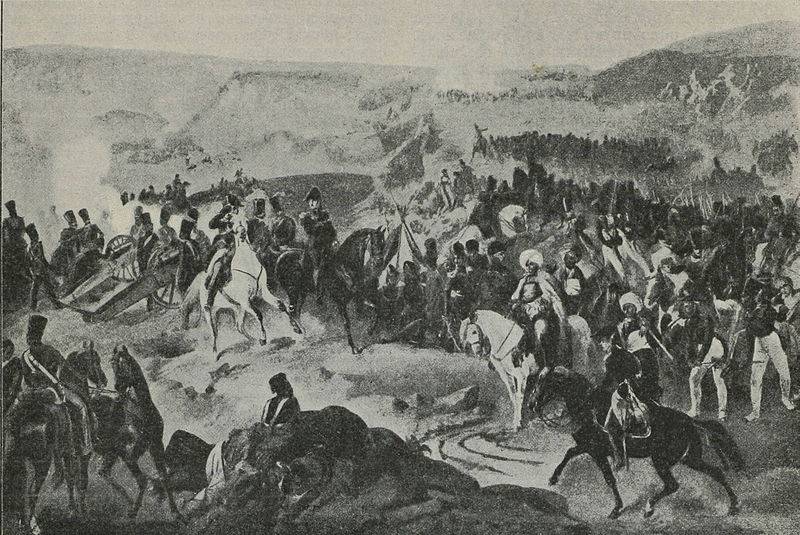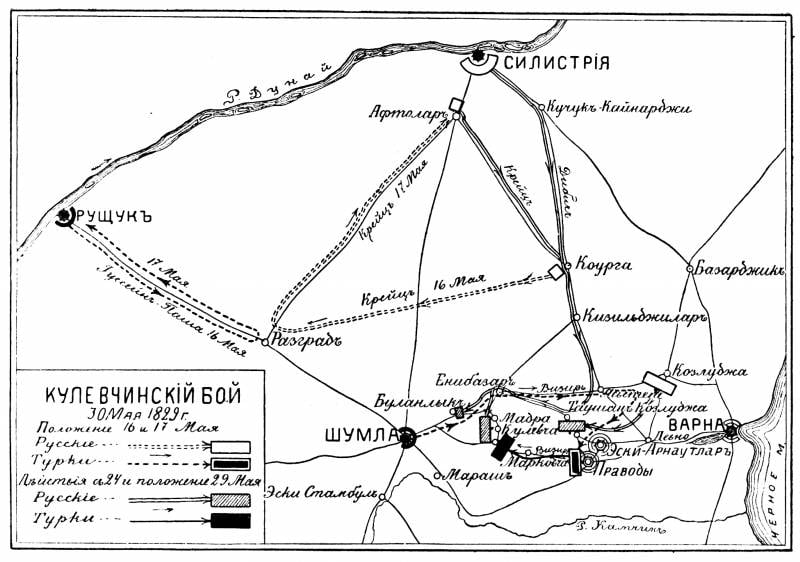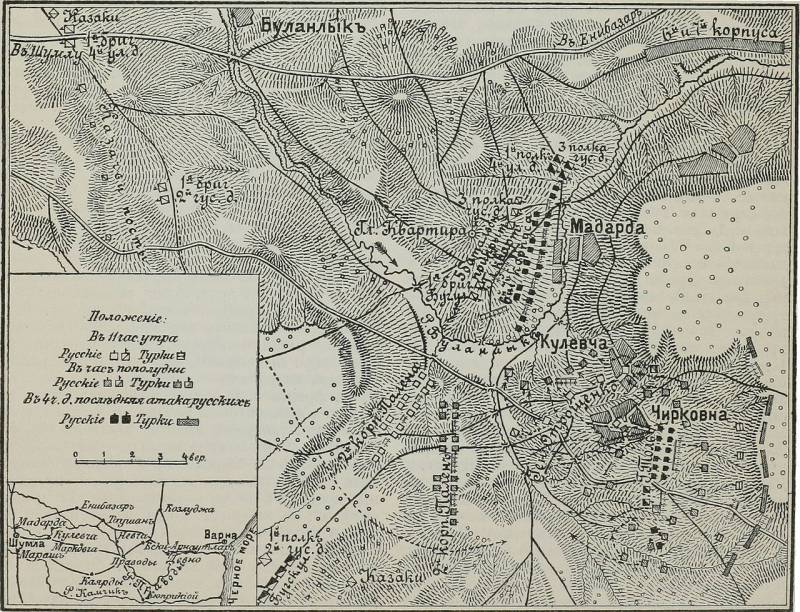Kulevchinskoye battle. How Dibich paved the way for the Russian army through the Balkans

Turkish offensive and Dibic army maneuver
The main task of the Russian army was the destruction of the manpower of the Ottomans. As soon as the Russian troops laid siege to Silistra, Dibich began to think how to lure the Turkish army into the open field and destroy it. The defeat of the Vizier’s army in a general battle decided the outcome of the war. The Turkish army at that time was based in the powerful fortress of Šumla, located west of Silistra, in the foothills of the Balkan Mountains. The fortress was prepared to house an entire army. Shumla locked the shortest and most convenient roads that led from Ruschuk and Silistra through the Balkans to Constantinople. The fortress was the headquarters of the grand vizier of the Ottoman Empire, Rashid Mehmed Pasha. The Turkish commander-in-chief was already noted during the suppression of the uprising of the Greeks in Morea and now he dreamed of defeating the "infidels."
Soon the Russian commander-in-chief was able to defeat the Turkish army. In mid-May 1829, the vizier, reinforced by reinforcements and bringing his army to 40 thousand, again launched an offensive. The Ottoman commander-in-chief was planning to crush a small Russian corps under the command of General Roth, located in the area of Pravoda. Mehmed Pasha decided to crush a separate Russian detachment, separated from the main forces of Dibich. According to Turkish intelligence, the main forces of Dibich were far from both Shumla and Pravo. The vizier hurried to destroy the troops of Roth and then quickly return under the protection of the walls of Shumla.
However, Dibich also watched the enemy and as soon as he learned about the movement of the enemy army, he decided to use the opportune moment to defeat the Vizier. He commissioned the completion of the siege of Silistra to General Krasovsky, to whom 30 of thousands of soldiers had been abandoned. Dibich himself quickly moved from Silistria to the rear of the Vizier, who at that time was walking towards Varna. On May 24, Russian troops with reinforced and quick marches reached the village of Madra (Madara). Strong escort provided the stealth and surprise of this march for the enemy. To the village of Madra, by order of the commander-in-chief, General Roth also moved with the main forces of his corps. Against the Turks at Pravod, he left a barrier under the command of General Kupriyanov (4 Infantry and 2 Cavalry Regiment). The Turks also missed this movement of the Russian troops. On May 30, Roth's troops successfully united with the main forces of Dibich. The number of Russian army was about 30 thousand people with 146 guns.
Thus, during the brilliant maneuver of the Russian troops, the Turkish army was cut off from its base in Shumla. Dibich got his way. The Ottomans had to accept a general battle. The vizier, whose troops had already besieged the Russian detachment from Pravod, learned about the movement of the Russian army only on May 29. At the same time, the Turkish command decided that the Russians, who had turned out to be Madra, were part of the Roth Corps, which had been thoughtlessly taking the lead. The Turkish commanders, remembering the experience of the 1828 campaign of the year, when the siege of strong Turkish fortresses was tied together by all the forces of the Russian army, believed that the Russians who besieged Silistra simply did not have large units to conduct offensive operations. The Ottomans did not expect to meet Madra with the main forces of Dibich. They were so sure of this that they did not even send cavalry to Shumla to conduct reconnaissance by force. Rashid Mehmed Pasha lifted the siege from the Russian fortifications at Pravo, where the Russians steadfastly fought off all the attacks and moved to Madram. The way there was through Kulevchensky gorge. The Ottomans hurried back in the hope of destroying the daring Russian detachment, which blocked their way to Shumla.
Start Kulevchinskogo battle
The battle began on May 30 (June 11) 1829, near the village of Kulevcha (Kyulevcha). Shumla was in 16 km from the battlefield, the Turkish troops with artillery and carts could cover this distance in one day's march. Dibich had less power than the enemy, but decided to attack. The terrain conditions did not allow the use of all troops. It was necessary to attack on a narrow section of a mountain pass bounded by mountains covered with forest. Later, Dibich was much criticized for not attacking the main forces.
Opponents have studied the situation for a long time. The Turks were stretched in motion and pulled up their parts. At about 11 hours, the commander-in-chief ordered General Yakov Otroshchenko (an experienced commander, a veteran of the wars against the French and the Turks), who commanded the Russian avant-garde, to attack the enemy located on the heights in the region of Chirkovna (Chirkovka). At the same time, on the right wing, Russian artillery forced the Turkish troops to take refuge in the forest and retreat beyond the slopes of the mountains. Using the confusion of the enemy, the Irkutsk Hussar Regiment with the support of the battalion of the Murom Infantry Regiment moved to occupy the heights cleared of the Turks. However, the Turks managed to prepare an ambush, placing it here and well disguising a strong artillery battery. When the Russian hussars and infantry turned out to be in front of the heights at Chirkovna, the Turkish gunners opened fire.
The Russian command responded by focusing horse-artillery batteries on this site, which were able to quickly arrive at this site and open fire. The Turkish battery was quickly put down. Also, the 11 th jäger regiment with 4 guns under the command of lieutenant colonel Sevastyanov, who was reinforced with the 2 battalion of the 12 jager regiment with 2 guns, was sent to attack heights.
The battle took on a violent temper. When our troops approached the position of the enemy ambush battery, already suppressed by our gunners, they were attacked by the masses of the Ottoman infantry. The Turks hid in a dense forest, waiting for the shelling. And now the Ottomans have rushed to our troops climbing the heights. Began a fierce hand-to-hand fight. The Murom infantrymen immediately became encircled and fought to the last (only 30 fighters remained from the battalion). The Irkutsk hussars, who could not turn around in the forest, knocked down Kulevchinsky heights, but they avoided encirclement. Three battalions of the 11 and 12 of the chasseurs regiments fought back with bayonets from the front and the flanks. Russian huntsmen resisted and retreated in perfect order, surprising the enemy and covering the way with the corpses of the enemies. Lieutenant Colonel Sevastyanov encouraged the soldiers with a banner in his hands. Rangers fought hard, but the situation was difficult. It became harder and harder for them to contain the onslaught of the superior forces of the enemy.
Turks go on the offensive
General Otroshchenko, to stop the advance of the Turkish camps (battalions) from the heights and support the rangers, ordered to put on the flank of 6 equestrian guns. The gunners quickly changed position and began to shoot the Ottomans with a canister, firing direct fire. In this case, the gunners tried to prevent the enemy from covering the rangers from the flanks, to surround and destroy them. However, the impact of artillery fire, and great losses did not stop the enraged masses of the Ottomans, who, with shouts of "Allah!", Continued their attack on the weakened chasseurs battalions. In addition, they were encouraged by the need for a breakthrough to the saving walls of Šumla.
Encouraged by the success of the first Grand Vizier ordered to launch an offensive on the left flank. The Ottomans, who had previously taken refuge in the mountain gorges, began moving and knocked down the 1 battalion of the 12 th Jäger regiment from the position. Numerical superiority allowed the Turks to conduct a dense rifle fire. Rangers retreated under pressure from the masses of enemy infantry and suffered heavy losses from their fire. Especially a lot of the wounded. Among the wounded were generals Otroshchenko and Glazenap, who led the battle. The vizier who watched the battles steadily increased the onslaught. He sent part of the troops around the right flank of the Russians. Now the Ottomans were advancing on the front, from the flanks. Rashid Mehmed Pasha sought to seize the initiative.
However, the Russian command was not asleep. The vanguard of the rangers received a strong reinforcement in the form of the first brigade of the 6 th infantry division, reinforced by a battery company of the 9 th artillery brigade. The Kaporsky Infantry Regiment with 2 guns was put forward as a brigade reserve. The brigade consisted of two regiments - Nevsky and Sophia. Her commander was Major General Lubomirsky. The Turks, inspired by the first successes, attacked the infantry brigade on the move. The brigade was built in a square and met the enemy with rifle volleys and bayonets. The Ottomans did not manage to break the breech and they suffered heavy losses. Distinguished battery company Colonel Valtsa. The guns beat up grapeshot from close range in 100 - 150 meters and literally mowed down the Turks. The Ottomans could not stand such a fierce fire and their onslaught for a while verse.
Meanwhile, the Russian commander-in-chief put forward new forces on the battlefield. It was the 1 Brigade of the 2 Hussar Division with 4 light guns under the command of Lieutenant General Budberg and the 19 I horse-mounted company under the command of Major General Arnoldi. While the cavalry and the horse artillery were hurrying to the right flank, the situation there again escalated. The Turkish troops, taking advantage of their numerical superiority, forced the small river Bulanlyk and launched an attack on the open flank of the Russian troops. However, here on the way the Turks got Arnoldi's horse-drawn company, just arrived at the scene. The gunners quickly saw the danger threatening our troops, and deployed batteries on the flank of the Russian infantry, opening fire on the enemy. Everything happened very quickly. No wonder then the Russian army said that when the horse artillery flies to the position, its wheels touch the ground only out of politeness.
The fire was very effective. A sudden shelling of grenades (cartel charges were already used) and even brandkuheli (incendiary artillery shells), upset the ranks of the Turkish army. The Turks were stunned, and a huge mass of infantry trampled on the spot. Turkish officers could not force their soldiers to go forward. This took advantage of the Russian infantry. The rangers and the infantry of the Nevsky and Sophia regiments together went to the attack and overturned the front ranks of the Turkish troops with a bayonet. Now it was not the Russians who fought back, but the Turks. Soon, the Russian artillerymen were delivered spare charging boxes with canister charges, and they began to smash the enemy first with a “closest” canister - from the distance 100 - 150 meters, then the “long-range” - from 200 - 300 meters.
The Turks would have retreated, but could not. All this time, new Turkish battalions emerged from the Kulevchinskiye gorge along a narrow mountain road. The Grand Vizier ordered to attack the enemy. However, the Turks had already exhausted, the former rage was gone, and the Ottoman troops, having suffered heavy losses, began to retreat to their original positions in the mountains. Entering into the battle the hussar brigade and additional artillery equalized the forces, while the Russians maintained their fighting spirit, and the ardor of the Turks died away. Therefore, the Ottomans soon stopped the attacks on the Russian right flank. Rashid Mehmed Pasha, seeing the futility of attacks on the right flank of the enemy, which seemed to him weak, ordered to withdraw the troops back to the mountains.
Defeat of the Turkish army
The battle stopped for a while. Both sides put the troops in order. Dibich replaced the tired parts of the first line with fresh troops, backed them up in advance. Bloodless Jaeger battalions were relegated to the rear. In addition, the Russian commander-in-chief remembered that there was a numerous Turkish garrison in Shumla, which had the opportunity to be in the Russian rear. Therefore, the barrier on the road to the fortress was strengthened. However, the Dibic army did not receive a strike to the rear. The Turkish command decided not to risk, withdrawing the troops remaining in the fortress, or the Turkish couriers simply did not pass through the Russian posts. In addition, the Turkish commanders held a meeting and concluded that the Russians were stronger than they thought and would be defeated in a field battle. It was necessary to go to Shumla.
The Turks believed that the battle that day was over. However, in the 5 hour, by the evening, Russian troops launched a broad front on the offensive on the Kulevchen Heights. The battle began with an artillery fire. Here an important role was played by the chief of the army of Toll, who personally arranged artillery batteries in front of the heights. The artillery duel ended in favor of the Russian artillerymen, who had incomparably better training than the Ottomans. In the mountain positions of the Turkish batteries, one after another, powder boxes exploded. Turkish gunners began to scatter. Soon the whole Ottoman army was in turmoil and fear. At first the infantry cover of the Turkish batteries turned to flight. On the only mountain road, where the carts of the Turkish army were stationed, a traffic jam immediately formed.
Noticing the confusion in the camp of the enemy, Dibich ordered the start of the offensive. The first to move to the heights of the forest detachments of the best shooters. Behind them were moving infantry columns. The offensive was so fast that the Turks had not yet come to their senses after the explosions in artillery positions. This attack ended in complete success. The Turkish army, already trembling and losing its morale, panicked. And when the Russian columns climbed the heights and went on the attack, the huge masses of the Turkish army fled. Attempts by individual groups to resist success did not lead. The Ottomans threw Kulevchen positions that were very convenient for a defensive battle.
The army of Rashid Mehmed Pasha very quickly turned into a crowd of fugitives. Everyone saved as he could. It was a complete rout. The Turkish army lost on this day only killed 5 thousand people, 2 thousand people were captured. Russian troops captured rich trophies: almost all of the Turkish army artillery (near 50 guns), a huge Ottoman army camp with thousands of tents and tents, the whole train with food supplies and ammunition. Russian casualties - over 2300 people killed and wounded. Most of them were Russian avant-garde fighters, who took the brunt of the enemy army.
The remains of the broken Turkish army found salvation in the wooded mountains, or fled along the only mountain road along which they came here. Russian cavalry drove the enemy 8 miles, but because of the conditions of the area could not turn around and finish off the enemy. Part of the Turkish army led by the vizier could still get into Shumla. Other scattered detachments and groups made their way south through the mountains. The other part, mostly local Muslim militias, just ran home.
Kulevchen victory was of strategic importance. Runaways everywhere talked about power weapons "Infidels", all fear and panic in the Ottoman troops. The best Turkish army was defeated, its remnants disappeared in Shumla. Dibich did not even use his main forces in battle. This allowed the Russian commander almost immediately to begin a march through the Balkans. Dibich decided not to waste time and energy on taking Šumly, remembering that his main goal was to throw through the Balkans, confining himself to watching her. Russian troops demonstrated that they were preparing for the siege of Shumla. The Grand Vizier, demoralized by defeating Kulevchi, and deceived by the actions of the Russians, hastily began in Shumla all available troops in northern and southeastern Bulgaria, including those detachments that defended the Balkan passes. Dibich was counting on this. With the capture of Silistra, which fell on 19 on June 1829, the liberated 3 corps began the siege of Šumly. And the main forces of the Russian army moved on the Zabalkan campaign, which began on July 3.


Information